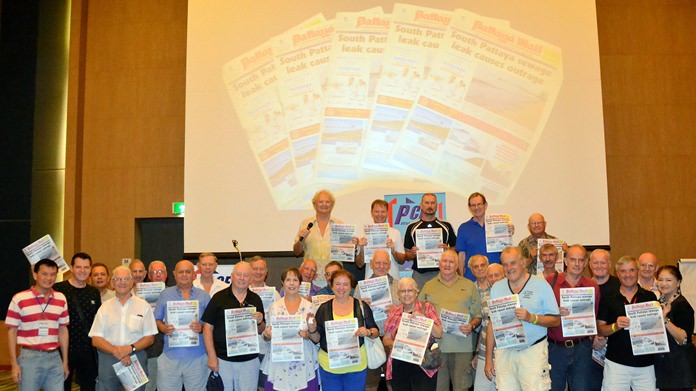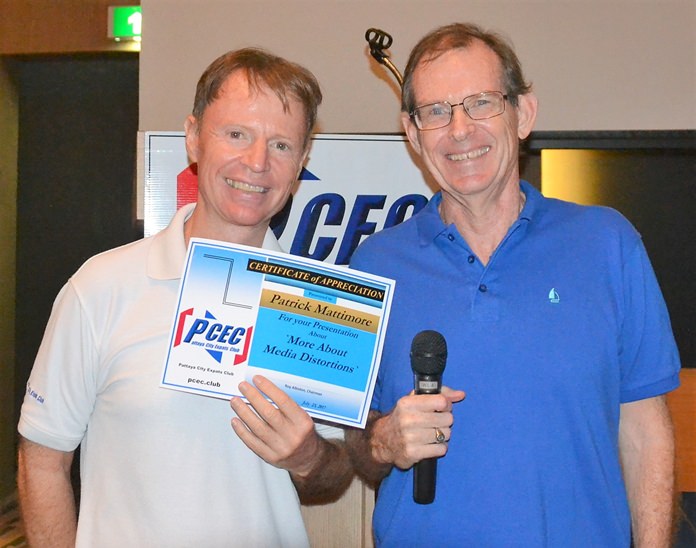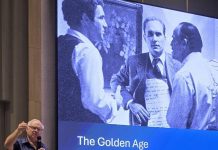
Widespread statistical illiteracy by the news media was one of the issues Patrick Mattimore commented on in his return to the Pattaya City Expats Club (PCEC) on July 23 for “More Media Distortions.” This was a follow up to his last presentation to the PCEC; previously, he spoke to the PCEC about “Writing for the Press When There’s no Free Press.” His focus for this latest presentation was on print and broadcast media’s inappropriate use of statistics, news releases, and use of anonymous sources.
Patrick has written commentaries for a variety of publications, daily newspapers, professional magazines, and weeklies. He is a member of the Society of Professional Journalists. His areas of expertise are law, psychology, and education.

The presentation opened with a quote from Charles Murray, an American political scientist: “Widespread statistical illiteracy… is cause for immediate concern because none of us, no matter how thorough our training, has the time to assess the data independently on every topic. We all have to rely on the quality of information we get from the media-and, as of today, that quality is terrible.”
Patrick’s primary theme was that we all need to be better consumers. He doesn’t believe that most journalists are trying to mislead the readers but that there are external pressures creating distortions. For example, he states that one of the most common journalistic errors is to compare percentages between two sets of data in which the percentages are not comparable because they are not a percentage of the same base number. He provided an example from a story trying to show “Racial Imbalance at Elite Public Schools”. The writer unfairly compared statistics from a large group of students to numbers from a small, highly sought, elite school, leading the readers to believe that the particular school was bad. The emphasis is, the reader needs to understand journalists don’t always get it right and you need to recognize that if something doesn’t make sense, you are likely correct and either accept the error or do more research to determine the truth.
Other areas where the press may fall into a trap of misleading reporting is the use of anonymous sources. These sources should raise skepticism in informed consumers. It makes it much more difficult for a reporter to make the story believable unless he has sources. However, whenever the source is anonymous, the reader is unable to determine the “stake” the anonymous source may have in providing information. There have been repeated examples of misrepresentations, therefore, the “Just Trust Us” mentality is becoming more and more of a “red flag” to the public and credibility in anonymous sources is waning.
Patrick also talked about the “Watergate Phenomenon” which involved two Washington Post Newspaper reporters, Bob Woodward and Carl Bernstein, using an anonymous source, “Deep Throat”, that eventually brought down U.S. President Nixon. He pointed out that many reporters recognized that the success of Woodward/Bernstein and they have tried to emulate their style, often to the detriment of good journalism.
He talked about a perceived scandal concerning an American baseball home-run hero, Barry Bonds, and a performance-enhancing company, BALCO. Although Barry never failed a drug test and was never punished by Major League Baseball, a couple of reporters from the San Francisco Chronical obtained Grand Jury information, which was supposed to be secret, that tarnished Barry’s reputation forever. This information was given by one of the lawyers involved in the proceedings that had a stake in the release of the information. In the United States, Grand Jury proceedings are secret and it is illegal to disclose evidence or testimony except in certain circumstances. Patrick mentioned the particular lawyer eventually served time for his crime.
“Video News Releases” are often a source of misleading journalism. Often local TV stations seek “human interest” stories and publish a piece about a possible “cure” to a disease, for example. The problem is, the source is often a company that sells the product being touted. There are many examples of “Video News Releases” issued by special interest groups/advertisers trying to promote a product for profit. These “Releases” are often slanted to color the news according to the point of view that the supplier wishes to present. Also, paid and unpaid government sources create misleading news releases. The problem is that the viewers are not informed that the release is, in fact, a product or political advertisement.
“Speed Kills” was another target of Patrick. The necessity to compete for news, including the internet, leads to inadequate fact checking, sensationalism and the spread of rumors. Newsrooms rarely have the time or interest to do much fact checking beyond the story they are handed. Examples of inadequate controls on reporters were provided. He cites, for example, a couple of well-known journalists caught fabricating published stories, quotations, people and events. Anytime this type of behavior is revealed, confidence in reported news is harmed and it is impossible to know the extent this problem exists. The motivation to “cheat” is often the need to get it out fast.
Patrick emphasizes that most journalists try their best to get the story right but there are ways that they “mess-up”. Several examples in his presentation need to be recognized by the user so that we become much better, and more educated, media consumers.
After the presentation, MC Ren Lexander brought everyone up to date on upcoming events. This was followed by the “Open Forum” portion of the meeting, where questions are asked and answered and comments made about expat living in Thailand.
After the event, Ren Lexander interviewed Patrick Mattimore about his presentation to the PCEC. To view the video, visit https://www.youtube.com/watch?v=DYT7dsvevqU.
For more information on the Club and their activities, visit www.pcec.club.




